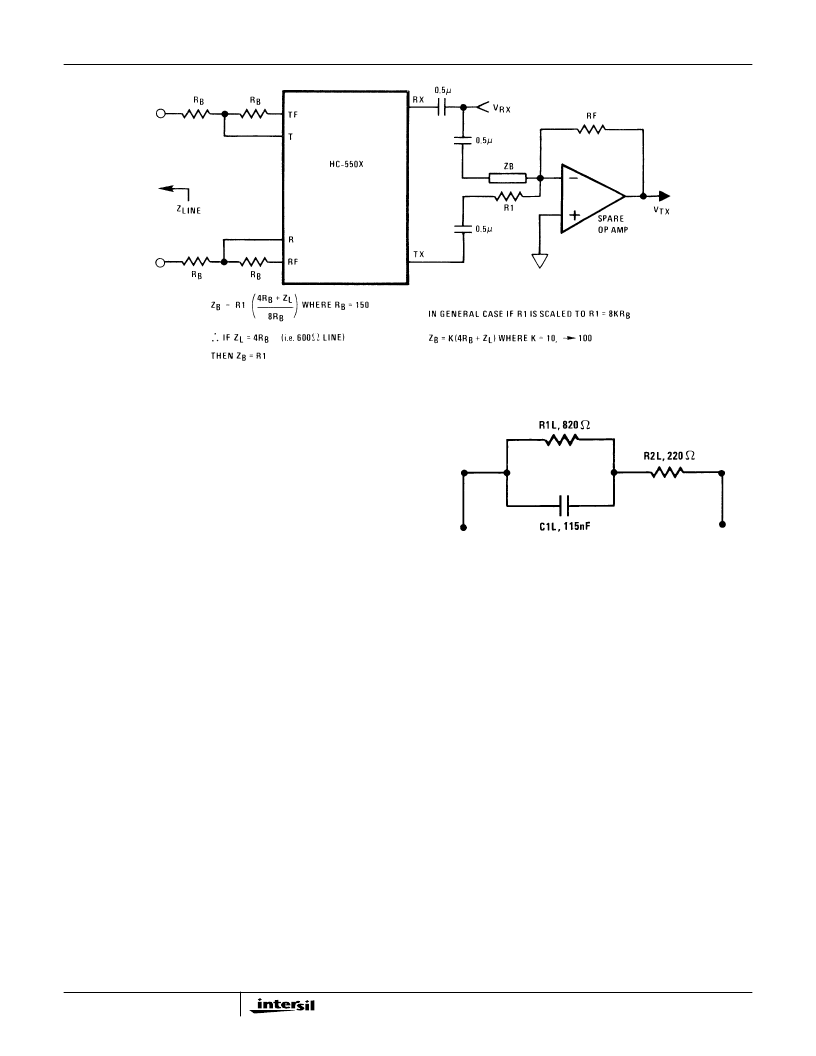- 您現在的位置:買賣IC網 > PDF目錄385353 > HC-5502X (Intersil Corporation) () PDF資料下載
參數資料
| 型號: | HC-5502X |
| 廠商: | Intersil Corporation |
| 英文描述: | () |
| 中文描述: | () |
| 文件頁數: | 12/17頁 |
| 文件大小: | 255K |
| 代理商: | HC-5502X |

4-12
Complex Impedance Matching
The SLIC is usually used in systems that have a line
characteristic impedance of 600
resistive. Thus, the 4 x
150
feed resistors present a balanced 600
load to the
line. If the characteristic impedance of the line varies from
600
but remains resistive, then this can be compensated
for by increasing or decreasing the value of R
B1
and R
B3
.
For example, if the line is defined as 900
resistive, then
R
B1
and R
B3
could be increased to 300
each and the line
will be matched. The increase in feed resistance could
impact the DC performance on long lines.
In cases of lines having a complex characteristic impedance,
the SLIC circuit can be configured to adequately match the
line. Figure 15 shows a typical equivalent line impedance as
defined in many European countries. Figure 16 illustrates
the circuitry required to match and balance such a line. The
component design equations are given in Appendix A along
with a qualitative description of the circuit to explain its
operation.
For the equivalent impedance shown in Figure 15, it can be
seen that at low frequencies, the impedance will increase and
become more resistive. As the voice frequency increases, the
reactance of C
L
decreases, thus the line impedance will also
decrease. In order to match the line impedance, a feedback
network is required that provides low frequency positive
feedback and high frequency negative feedback. The scheme
of Appendix A does this.
The degree of match over the voice band is a function of the R
and C component tolerances and the degree of approximation
to their theoretical values. The curves in Figure 16 show
typical matching characteristics. The objective is to maximize
the 2W return loss. Some values are indicated in Figure 16.
For complex impedance applications a certain amount of
circuit optimization will be required by the user in order to
obtain an adequate 2W return loss performance and a
satisfactory transmit frequency response.
FIGURE 14. SLIC TRANSHYBRID BALANCE EQUATIONS
HC-5502X/4X
FIGURE 15. RING TIP SEQUENCE
Application Note 549
相關PDF資料 |
PDF描述 |
|---|---|
| HC-5509A1 | SLIC Subscriber Line Interface Circuit |
| HC4P5509A1-9 | SLIC Subscriber Line Interface Circuit |
| HC4P5509A1-5 | SLIC Subscriber Line Interface Circuit |
| HC1-5509A1-5 | SLIC Subscriber Line Interface Circuit |
| HC3-5509A1-5 | SLIC Subscriber Line Interface Circuit |
相關代理商/技術參數 |
參數描述 |
|---|---|
| HC5503 | 制造商:INTERSIL 制造商全稱:Intersil Corporation 功能描述:Low Cost 24V SLIC For PABX / Key Systems |
| HC5503C | 制造商:INTERSIL 制造商全稱:Intersil Corporation 功能描述:Unbalanced PBX/Key System SLIC, Subscriber Line Interface Circuit |
| HC5503CB | 制造商:Rochester Electronics LLC 功能描述: 制造商:Intersil Corporation 功能描述: |
| HC5503CB96 | 制造商:Rochester Electronics LLC 功能描述:HC5503CB (TAPE&REEL) - Bulk |
| HC5503CBZ | 功能描述:電信線路管理 IC LW COST ISDN SLIC 24S0 RoHS:否 制造商:STMicroelectronics 產品:PHY 接口類型:UART 電源電壓-最大:18 V 電源電壓-最小:8 V 電源電流:30 mA 最大工作溫度:+ 85 C 最小工作溫度:- 40 C 安裝風格:SMD/SMT 封裝 / 箱體:VFQFPN-48 封裝:Tray |
發布緊急采購,3分鐘左右您將得到回復。